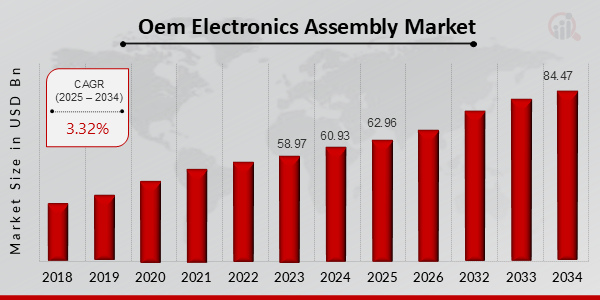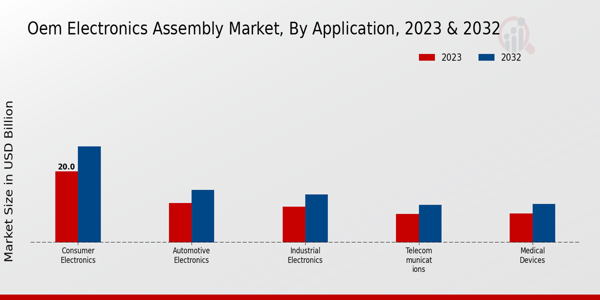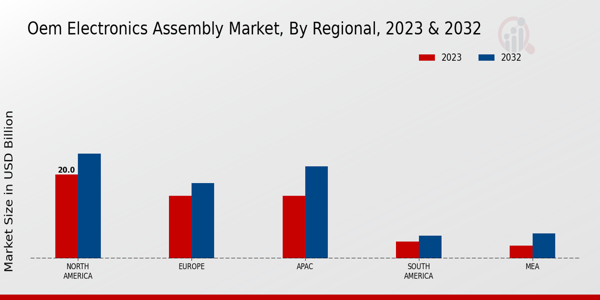OEM Electronics Assembly Market Overview
Oem Electronics Assembly Market is projected to grow from USD 62.96 Billion in 2025 to USD 84.47 Billion by 2034, exhibiting a compound annual growth rate (CAGR) of 3.32% during the forecast period (2025 - 2034).
Additionally, the market size for Oem Electronics Assembly Market was valued at USD 60.93 billion in 2024.
Key OEM Electronics Assembly Market Trends Highlighted
The OEM Electronics Assembly Market is witnessing significant growth driven by advancements in technology, increasing demand for high-quality electronics, and the shift towards smart devices. Manufacturers are focusing on enhancing efficiency and reducing production costs, which is pushing them to adopt innovative assembly techniques and automation in their processes. The rising trend of connected devices and the Internet of Things (IoT) is further stimulating the need for reliable electronic assembly solutions. As businesses seek to meet consumer demands for quicker delivery and customization, the importance of strong supply chain management becomes paramount.
There are new markets that include electric vehicles and renewable energy that are waiting to be tapped into. Companies will favor the trend of sustainability and source or use green materials in their assembly line. In addition, factories will be more efficient thanks to the incorporation of artificial intelligence and machine learning in the process. Thus, companies adopting these practices are more likely to improve their market position and gain more customers who require high-tech electronics assembly services. More recently, the trend has also been towards more integrated approaches by OEMs and their suppliers, thus improving the efficiency of the assembly.
The growing complexities of electronic devices have made it necessary for manufacturers to forge alliances to maintain the quality and accuracy of the assembly process. Furthermore, the trend toward miniaturization and lightweight components is influencing the design and fabrication methods used in the industry. Moreover, the use of flexible manufacturing systems has also increased in order to better address the changing demands of the marketplace. Changing consumer preferences will lead to a transition in the strategies of the OEM Electronics Assembly Market posing threats yet exciting opportunities to achieve growth.
Figure 1: OEM Electronics Assembly Market size 2025-2034

Source: Primary Research, Secondary Research, MRFR Database and Analyst Review
OEM Electronics Assembly Market Drivers
Increasing Demand for Consumer Electronics
The OEM Electronics Assembly Market Industry is experiencing significant growth driven primarily by the increasing demand for consumer electronics. With the rapid advancement of technology, consumers are leaning toward smarter and more efficient electronic devices that offer enhanced functionalities. Smartphones, tablets, smart home devices, and wearables are popular among tech-savvy consumers. These trends have led to higher production volumes and the need for sophisticated assembly solutions, fostering opportunities for OEM electronics assembly services.As manufacturers strive to meet consumer preferences for the latest technologies, they require dependable partners capable of delivering high-quality assembly processes. This demand for consumer electronics not only fuels the market but also encourages innovation in design and production techniques. Manufacturers must adapt to fast-changing trends and be agile in their production capabilities, leading to increased opportunities within the OEM Electronics Assembly Market Industry, which ultimately promotes sustainable growth alongside the evolving landscape of consumer demands.
Growth of the Internet of Things (IoT)
The rise of the Internet of Things (IoT) has significantly impacted the OEM Electronics Assembly Market Industry. As IoT devices such as sensors, smart appliances, and connected infrastructure become more prevalent, the need for effective assembly solutions grows. These devices often require complex assembly processes due to their intricate designs and varied functionalities. Consequently, manufacturers specializing in OEM electronics assembly are essential to efficiently bring these devices to market, thereby driving growth in the overall industry.As more industries adopt IoT technology, the demand for reliable assembly services is expected to expand.
Automation and Industry 4.0
The transition towards automation and Industry 4.0 principles is reshaping the OEM Electronics Assembly Market Industry. Manufacturers are increasingly integrating advanced robotics, machine learning, and data analytics into their assembly processes to enhance efficiency and reduce costs. This technology-driven shift promotes streamlined operations, higher precision in assembly tasks, and quicker turnaround times, allowing businesses to meet ever-increasing market demands.As companies strive to remain competitive, the implementation of automated solutions not only boosts production capacity but also directly contributes to the growth potential of the OEM electronics assembly market.
OEM Electronics Assembly Market Segment Insights
OEM Electronics Assembly Market Application Insights
The OEM Electronics Assembly Market is experiencing significant growth within its Application segment, projected to reach a total valuation of 57.07 USD Billion in 2023 and further expanding towards 76.45 USD Billion by 2032. This segment encompasses several crucial industries, with Consumer Electronics leading the charge, valued at 20.0 USD Billion in 2023 and expected to grow to 27.0 USD Billion by 2032. The strong consumer demand for devices like smartphones, tablets, and smart home appliances has solidified this sub-segment's majority holding in the market, driving innovation and assembly efficiencies.Following closely, Automotive Electronics represent a significant part of the market, valued at 11.0 USD Billion in 2023 and expected to rise to 14.7 USD Billion by 2032. The surge in electric vehicles and advanced driver-assistance systems highlights the growing importance of this segment, contributing to its robust growth trajectory.
Industrial Electronics account for a market value of 10.0 USD Billion in 2023, with a projection of 13.5 USD Billion by 2032. This segment is vital because it supports automation in manufacturing processes, and the advancement of Industry 4.0 solutions significantly drives market growth.Telecommunications, with a valuation of 8.0 USD Billion in 2023, rising to 10.5 USD Billion by 2032, plays a crucial role in global connectivity, emphasizing the necessity for reliable assembly processes in high-quality communication devices. Lastly, with a value of 8.07 USD Billion in 2023 and an expected rise to 10.75 USD Billion in 2032, the Medical Devices segment highlights the importance of precision and reliability in manufacturing assemblies for life-saving devices, ensuring compliance with stringent regulations.
The diverse Applications within the OEM Electronics Assembly Market offer numerous opportunities for growth, highlighting the essential role these segments play in today's technology-driven world as they cater to increasing consumer needs and evolving industry standards.Growth drivers such as rising consumer electronics demand, the shift towards electric vehicles, and the push for automation in industries continue to illustrate the vitality and expansive nature of this market sector. Nonetheless, challenges like supply chain complexities and the need for technological advancements remain prevalent. Understanding these dynamics through market statistics and data offers valuable insight into the current trends influencing the OEM Electronics Assembly Market and its segmentation.

Source: Primary Research, Secondary Research, MRFR Database and Analyst Review
OEM Electronics Assembly Market Assembly Type Insights
The OEM Electronics Assembly Market showcases a diverse range of assembly types that cater to various manufacturing needs. In 2023, this market is valued at approximately 57.07 billion USD, reflecting a robust demand for efficient assembly solutions. The classification into assembly types includes Surface Mount Technology, which is a preferred method due to its efficiency and space-saving design, and Through-Hole Technology, known for its durability, particularly in heavy-duty applications. Mixed Technology combines both techniques, offering flexibility in assembly processes.
Manual Assembly remains significant for custom and prototype production, where precision is key, while Automated Assembly is increasingly dominating due to its speed and cost-effectiveness in high-volume production. The ongoing market growth is driven by advancements in technologies and increasing demand for compact electronic devices. However, challenges such as skilled labor shortages and the need for continual innovation pose concerns for manufacturers in this segment. The OEM Electronics Assembly Market segmentation highlights the critical role that each type plays in meeting industry demands and adapting to changing technology landscapes, thus presenting opportunities for ongoing development and investment in assembly capabilities
OEM Electronics Assembly Market End Use Industry Insights
The OEM Electronics Assembly Market stood at a value of 57.07 billion USD in 2023 and is poised for substantial growth over the coming years. This market encompasses various end use industries, including Automotive, Healthcare, Telecommunications, Aerospace, and Consumer Goods. The Automotive sector plays a crucial role due to the increasing demand for advanced electronic systems in vehicles, promoting more efficient and connected transportation solutions. In Healthcare, the rising reliance on electronic medical devices drives significant market engagement, reflecting its vital contribution to improved patient care.
Telecommunications remains a dynamic segment, buoyed by rapid advancements in communication technologies and infrastructure expansion. Aerospace focuses on high-quality and reliable electronics required for safety-critical applications, showcasing its importance. Meanwhile, Consumer Goods are characterized by a need for innovative electronics across everyday products, enhancing convenience and user experience. With the global shift towards digitization and automation, these sectors are expected to leverage advanced OEM assembly solutions, indicating solid prospects for the overall market.The combination of robust market engagement and technological advancements lays the groundwork for significant market growth opportunities in the coming years.
OEM Electronics Assembly Market Product Type Insights
The OEM Electronics Assembly Market witnessed a valuation of 57.07 billion USD in 2023, reflecting a trend toward increased production efficiency and technological advancement. The market is characterized by product types such as Printed Circuit Board Assemblies, Electromechanical Assemblies, Systems Integration Assemblies, and Custom Assemblies. Among these, Printed Circuit Board Assemblies stand out for their crucial role in various electronic devices, driving a majority of the market's demand. Electromechanical Assemblies have also gained significance, catering to industries like automotive and consumer electronics with their robust functionality.
Systems Integration Assemblies contribute significantly by streamlining complex electronic systems and enhancing performance across applications. Custom Assemblies meet the specific needs of clients, offering tailored solutions that strengthen market growth. With advancements in automation and the Internet of Things (IoT), the OEM Electronics Assembly Market segmentation is poised for further expansion, supported by a growing necessity for integrated electronic solutions across diverse industries. Overall, the OEM Electronics Assembly Market statistics reveal a promising landscape driven by innovation and efficiency in product offerings.
OEM Electronics Assembly Market Regional Insights
The OEM Electronics Assembly Market is poised for robust growth, with a significant focus on regional segmentation. In 2023, the market was valued at 57.07 USD Billion, with major contributions from various regions. North America leads the market with a valuation of 20.0 USD Billion, reflecting its dominance and robust manufacturing infrastructure. Europe follows with a valuation of 15.0 USD Billion, driven by advancements in technology and high-quality standards. APAC also holds a noteworthy share, valued at 15.0 USD Billion in 2023, fueled by rapid industrialization and a large electronics consumer base.South America and MEA are smaller segments, valued at 4.0 USD Billion and 3.07 USD Billion, respectively, but they present significant opportunities for growth due to increasing investments and rising demand for electronics.
The overall market is influenced by trends such as the shift toward automation and the increasing importance of sustainable manufacturing practices, acting as key growth drivers. However, challenges like supply chain disruptions and fluctuating material costs continue to pose risks, making the competitive landscape dynamic.Insights from the OEM Electronics Assembly Market data suggest a varied regional performance, with North America and APAC expected to remain central to future market statistics, underpinned by ongoing innovations and strategic collaborations within the industry.

Source: Primary Research, Secondary Research, MRFR Database and Analyst Review
OEM Electronics Assembly Market Key Players and Competitive Insights
The OEM Electronics Assembly Market is characterized by a dynamic landscape that reflects the rapidly evolving technology sector where innovation and efficiency are paramount. Companies operating within this market strive to meet the increasing demand for high-quality electronic components while navigating challenges such as supply chain disruptions and fluctuating material costs. Competitive insights into this market indicate that organizations are leveraging advanced manufacturing techniques and adhering to strict quality standards to maintain their market position. The market is witnessing a trend towards sustainable practices and automation, which are becoming essential for companies aiming to enhance their operational efficiency and reduce costs.
The integration of smart technologies is also becoming crucial, allowing companies to achieve greater accuracy and flexibility in their manufacturing processes. Jabil stands as a prominent player in the OEM Electronics Assembly Market, known for its extensive service offerings and global footprint. The company boasts a diversified portfolio that spans various sectors, including automotive, healthcare, and energy, enabling it to mitigate risks associated with market volatility. Jabil has established itself through a blend of technological innovation and operational excellence, allowing the company to respond swiftly to customer demands while maintaining high manufacturing standards. Furthermore, Jabil’s commitment to sustainability sets it apart, as it invests heavily in eco-friendly practices and aims to reduce its environmental footprint. With access to advanced manufacturing capabilities, Jabil is well-positioned to capitalize on the growing trend of smart manufacturing, ultimately enhancing its competitive edge within the market.
Flextronics, now rebranded as Flex, represents another key player in the OEM Electronics Assembly Market, underscoring the company's adaptability to market changes and customer requirements. Flex has a strong emphasis on providing end-to-end solutions, from design to manufacturing, which allows it to cater effectively to a diverse clientele. One of the core strengths of Flex lies in its global operations, ensuring it can deliver localized support to customers while benefitting from economies of scale. The company has invested significantly in technology and innovation, which promotes efficiency and quality in its operations. Flex also prioritizes sustainability, displaying a strong commitment to reducing waste and improving energy efficiency in its production processes. This focus not only reinforces its market position but also addresses growing consumer demand for environmentally responsible manufacturing practices. Overall, Flex's strategic initiatives and robust capabilities contribute to its notable presence in the competitive landscape of the OEM Electronics Assembly Market.
Key Companies in the OEM Electronics Assembly Market Include
OEM Electronics Assembly Market Industry Developments
Recent developments in the OEM Electronics Assembly Market show a continuous evolution driven by technological advancements and increasing demand for consumer electronics. Companies such as Jabil and Flextronics have been expanding their capabilities through investments in automation and AI technologies to enhance manufacturing efficiency. Meanwhile, Foxconn and Pegatron are benefiting from the rising demand for electric vehicles and 5G technologies, which are pushing the limits of electronic assemblies. CTS Corporation and Celestica are also focusing on sustainable manufacturing practices to appeal to environmentally conscious consumers.
Current affairs highlight a trend towards consolidation in the market, with significant mergers and acquisitions being explored, although no recent large-scale deals specifically concerning the noted companies have been announced. In terms of market valuation, companies like Sanmina and Compal Electronics are witnessing growth, attributed to increased orders amid recovering global supply chains. The ongoing geopolitical tensions have prompted companies to seek diversification in their manufacturing locations, impacting strategies for companies like Wistron and Inventec. Furthermore, the market outlook remains positive, with a projected increase in investment in R&D across several key players aimed at fostering innovation and meeting future demands.
OEM Electronics Assembly Market Segmentation Insights
-
OEM Electronics Assembly Market Application Outlook
-
Consumer Electronics
-
Automotive Electronics
-
Industrial Electronics
-
Telecommunications
-
Medical Devices
-
OEM Electronics Assembly Market Assembly Type Outlook
-
Surface Mount Technology
-
Through-Hole Technology
-
Mixed Technology
-
Manual Assembly
-
Automated Assembly
-
OEM Electronics Assembly Market End Use Industry Outlook
-
Automotive
-
Healthcare
-
Telecommunications
-
Aerospace
-
Consumer Goods
-
OEM Electronics Assembly Market Product Type Outlook
-
Printed Circuit Board Assemblies
-
Electromechanical Assemblies
-
Systems Integration Assemblies
-
Custom Assemblies
-
OEM Electronics Assembly Market Regional Outlook
-
North America
-
Europe
-
South America
-
Asia Pacific
-
Middle East and Africa
OEM Electronics Assembly Market Report Scope
|
Report Attribute/Metric
|
Details
|
|
Market Size 2024
|
60.93 (USD Billion)
|
|
Market Size 2025
|
62.96 (USD Billion)
|
|
Market Size 2034
|
84.47 (USD Billion)
|
|
Compound Annual Growth Rate (CAGR)
|
3.32% (2025 - 2034)
|
|
Report Coverage
|
Revenue Forecast, Competitive Landscape, Growth Factors, and Trends
|
|
Base Year
|
2024
|
|
Market Forecast Period
|
2025 - 2034
|
|
Historical Data
|
2019 - 2023
|
|
Market Forecast Units
|
USD Billion
|
| Key Companies Profiled |
Jabil, Flextronics, Plexus, Foxconn, Pegatron, CTS Corporation, Hon Hai Precision Industry, Inventec, Celestica, Wistron, Sanmina, KuangChi, Benchmark Electronics, Qisda, Compal Electronics |
| Segments Covered |
Application, Assembly Type, End Use Industry, Product Type, Regional |
| Key Market Opportunities |
Increasing demand for smart devices, Growth in automotive electronics, Expansion of 5G technology, Rising trend of miniaturization, Sustainable manufacturing practices adoption |
| Key Market Dynamics |
Rising demand for electronic devices, Increasing outsourcing of manufacturing, Technological advancements in assembly processes, Growing importance of sustainability, Stringent quality and regulatory standards |
| Countries Covered |
North America, Europe, APAC, South America, MEA |
Frequently Asked Questions (FAQ) :
The OEM Electronics Assembly Market is expected to reach a value of 84.47 USD Billion by 2034
The market is projected to grow at a CAGR of 3.3% from 2025 to 2034
The Consumer Electronics segment is anticipated to hold the largest market share, valued at 27.0 USD Billion in 2032.
The Automotive Electronics segment is expected to be valued at 14.7 USD Billion in 2032.
North America is forecasted to reach a market size of 25.0 USD Billion by 2032.
The Industrial Electronics segment is expected to be valued at 13.5 USD Billion in 2032.
Key players include Jabil, Flextronics, Plexus, Foxconn, and Pegatron, among others.
The Telecommunications segment is projected to reach a market size of 10.5 USD Billion by 2032.
The Medical Devices segment is expected to be valued at 10.75 USD Billion in 2032.
Europe is expected to reach a market value of 18.0 USD Billion by 2032.

















